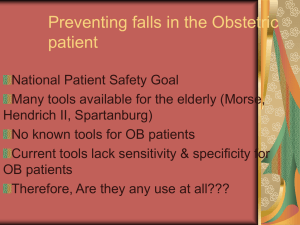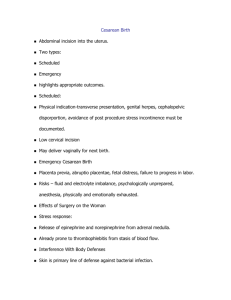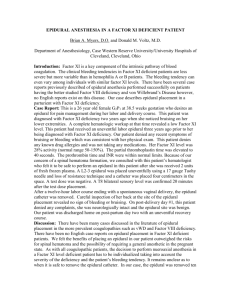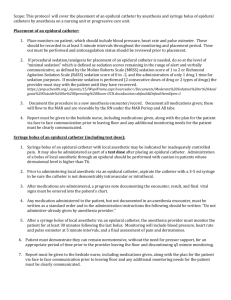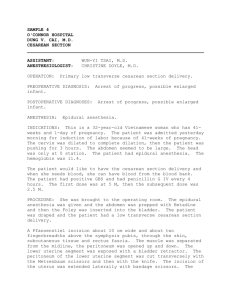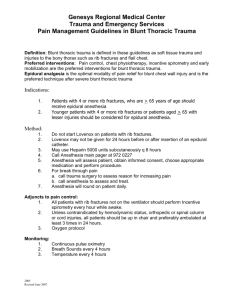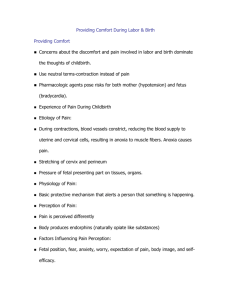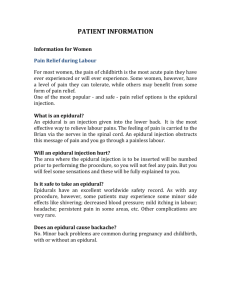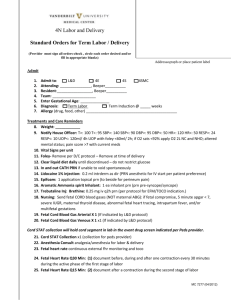Epidural Anesthesia
advertisement
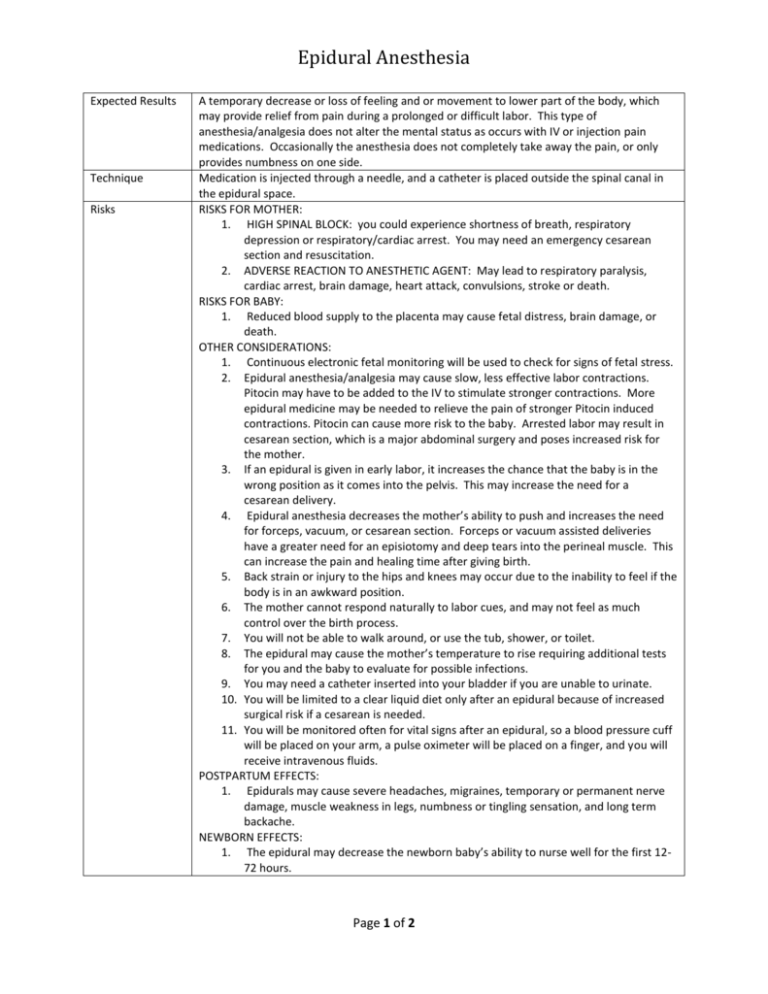
Epidural Anesthesia Expected Results Technique Risks A temporary decrease or loss of feeling and or movement to lower part of the body, which may provide relief from pain during a prolonged or difficult labor. This type of anesthesia/analgesia does not alter the mental status as occurs with IV or injection pain medications. Occasionally the anesthesia does not completely take away the pain, or only provides numbness on one side. Medication is injected through a needle, and a catheter is placed outside the spinal canal in the epidural space. RISKS FOR MOTHER: 1. HIGH SPINAL BLOCK: you could experience shortness of breath, respiratory depression or respiratory/cardiac arrest. You may need an emergency cesarean section and resuscitation. 2. ADVERSE REACTION TO ANESTHETIC AGENT: May lead to respiratory paralysis, cardiac arrest, brain damage, heart attack, convulsions, stroke or death. RISKS FOR BABY: 1. Reduced blood supply to the placenta may cause fetal distress, brain damage, or death. OTHER CONSIDERATIONS: 1. Continuous electronic fetal monitoring will be used to check for signs of fetal stress. 2. Epidural anesthesia/analgesia may cause slow, less effective labor contractions. Pitocin may have to be added to the IV to stimulate stronger contractions. More epidural medicine may be needed to relieve the pain of stronger Pitocin induced contractions. Pitocin can cause more risk to the baby. Arrested labor may result in cesarean section, which is a major abdominal surgery and poses increased risk for the mother. 3. If an epidural is given in early labor, it increases the chance that the baby is in the wrong position as it comes into the pelvis. This may increase the need for a cesarean delivery. 4. Epidural anesthesia decreases the mother’s ability to push and increases the need for forceps, vacuum, or cesarean section. Forceps or vacuum assisted deliveries have a greater need for an episiotomy and deep tears into the perineal muscle. This can increase the pain and healing time after giving birth. 5. Back strain or injury to the hips and knees may occur due to the inability to feel if the body is in an awkward position. 6. The mother cannot respond naturally to labor cues, and may not feel as much control over the birth process. 7. You will not be able to walk around, or use the tub, shower, or toilet. 8. The epidural may cause the mother’s temperature to rise requiring additional tests for you and the baby to evaluate for possible infections. 9. You may need a catheter inserted into your bladder if you are unable to urinate. 10. You will be limited to a clear liquid diet only after an epidural because of increased surgical risk if a cesarean is needed. 11. You will be monitored often for vital signs after an epidural, so a blood pressure cuff will be placed on your arm, a pulse oximeter will be placed on a finger, and you will receive intravenous fluids. POSTPARTUM EFFECTS: 1. Epidurals may cause severe headaches, migraines, temporary or permanent nerve damage, muscle weakness in legs, numbness or tingling sensation, and long term backache. NEWBORN EFFECTS: 1. The epidural may decrease the newborn baby’s ability to nurse well for the first 1272 hours. Page 1 of 2 Epidural Anesthesia _____ All forms of anesthesia or medications have some risk, and rare unexpected complications other than what is listed here may occur. _____I understand that it is my choice to choose the type of pain relief method I feel is appropriate for my baby’s birth including an epidural, IV pain medications, or comfort measures as listed on my birth plan. _____If I choose an epidural, I understand that every effort will be made to get an epidural administered in a timely manner. I understand an epidural may not be appropriate if the labor is advancing quickly and the procedure cannot be done safely. _____If a cesarean delivery becomes necessary, the epidural may be adequate anesthesia for surgery but general anesthesia may be necessary if complete pain relief is not achieved. _____I have had the opportunity to ask my OB physician or midwife questions regarding pain relief methods for labor and delivery. ____I understand this is NOT A CONSENT FORM FOR THE PROCEDURE OF THE EPIDURAL, but is confirmation that I have been educated on the effects of an epidural which may affect the obstetrical care I receive from my physician or midwife. If I choose to have an epidural during my labor, the anesthesia provider who will be administering the epidural will also inform me of risks associated with the procedure. Please initial the above statements, and sign below. Patient Signature Date OB Provider Signature Date Page 2 of 2
